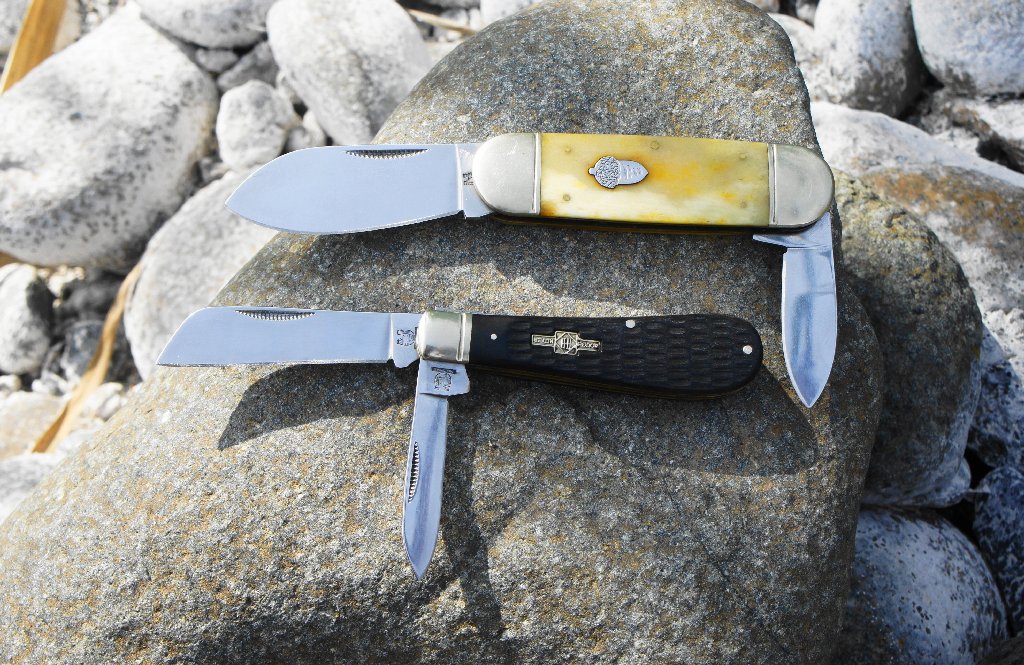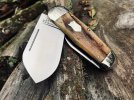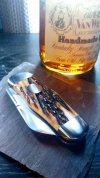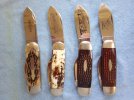-
The BladeForums.com 2024 Traditional Knife is available! Price is $250 ea (shipped within CONUS).
Order here: https://www.bladeforums.com/help/2024-traditional/
You are using an out of date browser. It may not display this or other websites correctly.
You should upgrade or use an alternative browser.
You should upgrade or use an alternative browser.
Show me your Elephant Toes.
- Thread starter Mack
- Start date
I Picked this one up at an estate sale. Still trying to figure out the year. As far as I can tell it’s in the 1920’s to 1940’s model, given the lack of any number markings. I am not finding many photo examples depicting the difference between the "greenbone" and the "Redbone." I'm a fixed blade knife maker so vintage collecting is all new to me. Any points in the right direction are appreciated!


Last edited:
black mamba
Gold Member
- Joined
- Oct 21, 2009
- Messages
- 23,581
Since this thread has been resurrected, do the newer GEC #46 Whalers fit here? Let's see 'em!


JOELSM
Gold Member
- Joined
- Aug 30, 2007
- Messages
- 3,842
Nice resurrection!
GEC 36


GEC 46 in Iron Wood


AGR Sunfish


Does anyone have the recently released AGR? They apparently sold out the first day they were released. I have one on back order when they drop in July. Who can show one off from the first run?
GEC 36


GEC 46 in Iron Wood


AGR Sunfish


Does anyone have the recently released AGR? They apparently sold out the first day they were released. I have one on back order when they drop in July. Who can show one off from the first run?
Just for the sake of discussion, I was under the impression that...
The Sunfish pattern has equal ends
The Elephant toe pattern has a slightly tapered end , on one end.
Or does it really matter ? Just saying.
The Sunfish/Elephant toe has always intrigued me.
I'm not sure what was the intended use for the pattern. Rope or leather cutting?
Anyone know, or have a theory?
The Sunfish pattern has equal ends
The Elephant toe pattern has a slightly tapered end , on one end.
Or does it really matter ? Just saying.
The Sunfish/Elephant toe has always intrigued me.
I'm not sure what was the intended use for the pattern. Rope or leather cutting?
Anyone know, or have a theory?
Fodderwing
Gold Member
- Joined
- Jan 31, 2017
- Messages
- 9,182
- Joined
- Mar 8, 2011
- Messages
- 1,452
Here's mine & it has been carried & used though only in jacket pockets as it's too heavy for jeans or shorts.

It isn't as practical as more mainstream patterns but I just love it for being different, almost a cartoon knife!

It isn't as practical as more mainstream patterns but I just love it for being different, almost a cartoon knife!
Last edited:
yablanowitz
Platinum Member
- Joined
- Apr 14, 2006
- Messages
- 10,021
Just for the sake of discussion, I was under the impression that...
The Sunfish pattern has equal ends
The Elephant toe pattern has a slightly tapered end , on one end.
Or does it really matter ? Just saying.
The Sunfish/Elephant toe has always intrigued me.
I'm not sure what was the intended use for the pattern. Rope or leather cutting?
Anyone know, or have a theory?
To a purist, yes Sunfish is equal end and toenail (or sleeveboard) is tapered. For the most part, Sunfish/Elephant Toenail/Sleeveboard get lumped together and the names get used interchangeably.
From what little history I've been able to find, they started out as rope knives in the early oilfield days.
To a purist, yes Sunfish is equal end and toenail (or sleeveboard) is tapered. For the most part, Sunfish/Elephant Toenail/Sleeveboard get lumped together and the names get used interchangeably.
From what little history I've been able to find, they started out as rope knives in the early oilfield days.
Thanks for your response yablanowitz
Yeah, admitted purist here , and I thought some others might be interested in the topic.
- Joined
- May 22, 2011
- Messages
- 2,818
Your IMGUR picture is not showing up.I Picked this one up at an estate sale. Still trying to figure out the year. As far as I can tell it’s in the 1920’s to 1940’s model, given the lack of any number markings. I am not finding many photo examples depicting the difference between the "greenbone" and the "Redbone." I'm a fixed blade knife maker so vintage collecting is all new to me. Any points in the right direction are appreciated!
- Joined
- May 22, 2011
- Messages
- 2,818
The rope knife story comes from Case's ads and marketing literature of the 50s or 60s. They called it an Olde English Rope Knife.
Trouble is, I have NEVER seen any other references than this. I do not put much stock in the pronouncements of marketing departments. Ka-Bar's marketing department pushed the story that Ka-Bar meant Killed-a-Bear, when what it REALLY meant was CaseBrothers-in-law.
The sunfish is really not designed for rope. A rope knife needs a long straight cutting edge, and a very stout blade and joint. It does not need a pen blade. It usually needs a bail, or at least a lanyard hole.
Both SUNFISH and ELEPHANT TOENAIL are descriptive of the size and shape of the knife. It is not much use as a fishing knife, and I have never tried doing pedicures on elephants, with or without a pocketknife.
The oldest one I have seen that could be positively dated is in the Wells Fargo Bank History Room in San Francisco. It was taken from a stage coach robber when he was arrested. I forget the details and the exact date, but it was late 19th century. You could ask them...
As I point out in LG4, there are variations to this pattern, as there are to most patterns. There are equal-end, sleeveboard, and swell-center sunfish, as well as different sizes. Terry Davis makes a nice looking swell-center version now, based on the old Platts pattern.
I don't know who created the pattern, or what they intended for it. Maybe a pocket skinning knife. Some patterns can be tracked back to their inventor and moment of creation -- the Wharncliffe, the lobster, the Scout knife, the Buck 110. Most cannot.
Ken Warner once told me that when he was a boy, before WWII in Minnesota, linemen often used this pattern for skinning insulation off of heavy electrical cable. Nowadays the usual pattern for this job is the lockback pruner.
BRL...
------------------
http://pweb.netcom.com/~brlevine/links.htm
- Joined
- Jul 14, 2019
- Messages
- 26
I must say this is a fascinating thread. I am interested in this style, but only aesthetically speaking, because it is a simply beautiful style. My personal tastes tend to go more from knives like the Cheetah. Anyway I was wondering why this particular knife, which in reality is absolutely nothing special (sorry guys, except the fancy versions)is priced like they were all made and marketed by Benchmade. Frankly I just can't justify a price hovering around $200. for a basic toenail(& etc)knife. I collect Case among others, and these knives are like little Gems. However, few styles routinely sell for the prices that these toenails routinely bring. I was just wondering what your thoughts on this might be? Is it simply marketing?
Rookie82
Gold Member
- Joined
- Nov 25, 2014
- Messages
- 2,479
I must say this is a fascinating thread. I am interested in this style, but only aesthetically speaking, because it is a simply beautiful style. My personal tastes tend to go more from knives like the Cheetah. Anyway I was wondering why this particular knife, which in reality is absolutely nothing special (sorry guys, except the fancy versions)is priced like they were all made and marketed by Benchmade. Frankly I just can't justify a price hovering around $200. for a basic toenail(& etc)knife. I collect Case among others, and these knives are like little Gems. However, few styles routinely sell for the prices that these toenails routinely bring. I was just wondering what your thoughts on this might be? Is it simply marketing?
There are a few reasons why they tend to be a bit more money.
--They are actually bigger knives with more steel in them, and larger handle slabs, which adds a tad more to producing them.
--They are collectible because they are impressive to see with such a fat master blade, and also because they are instantly recognizable. They are never confused with any other pattern.
--They have a history. The pattern has been made for over 100 years. Most brands of traditional knives made over the years have released this pattern. So there are plenty to collect.
As far as people using them, I don't really hear that collectors carry them very often. Too heavy and cumbersome for most normal everyday use. But guys really love to show them off.
- Joined
- Mar 8, 2011
- Messages
- 1,452
Anyway I was wondering why this particular knife, which in reality is absolutely nothing special (sorry guys, except the fancy versions)is priced like they were all made and marketed by Benchmade. Frankly I just can't justify a price hovering around $200. for a basic toenail(& etc)knife.
I assume you're dismissing Rough Riders (see my post #88), 20 bucks should get you one of a few different styles, a good way to see if you like one.
Mine is a pretty decent knife, astounding for the money.
Bigfattyt
Gold Member
- Joined
- Jun 23, 2007
- Messages
- 19,240
I must say this is a fascinating thread. I am interested in this style, but only aesthetically speaking, because it is a simply beautiful style. My personal tastes tend to go more from knives like the Cheetah. Anyway I was wondering why this particular knife, which in reality is absolutely nothing special (sorry guys, except the fancy versions)is priced like they were all made and marketed by Benchmade. Frankly I just can't justify a price hovering around $200. for a basic toenail(& etc)knife. I collect Case among others, and these knives are like little Gems. However, few styles routinely sell for the prices that these toenails routinely bring. I was just wondering what your thoughts on this might be? Is it simply marketing?
Partly fewer made. Custom maker dislike making them. Large blades with complex grinds. Single spring, bur typically a very strong spring. Larger pieces of cover material, which have to be defect free. It is much harder to bookend stag, or other material pieces in the size and flatness needed.
Blade grinds must fit nested together, and the spring has to be tuned so each end is appropriate open strength to match the blade sizes.
I have a few GEC, I did not pay $200. I paid $136 for the sunfish, $140 or so for the ironwood swell center and $90 for the all steel bone covered one.
















